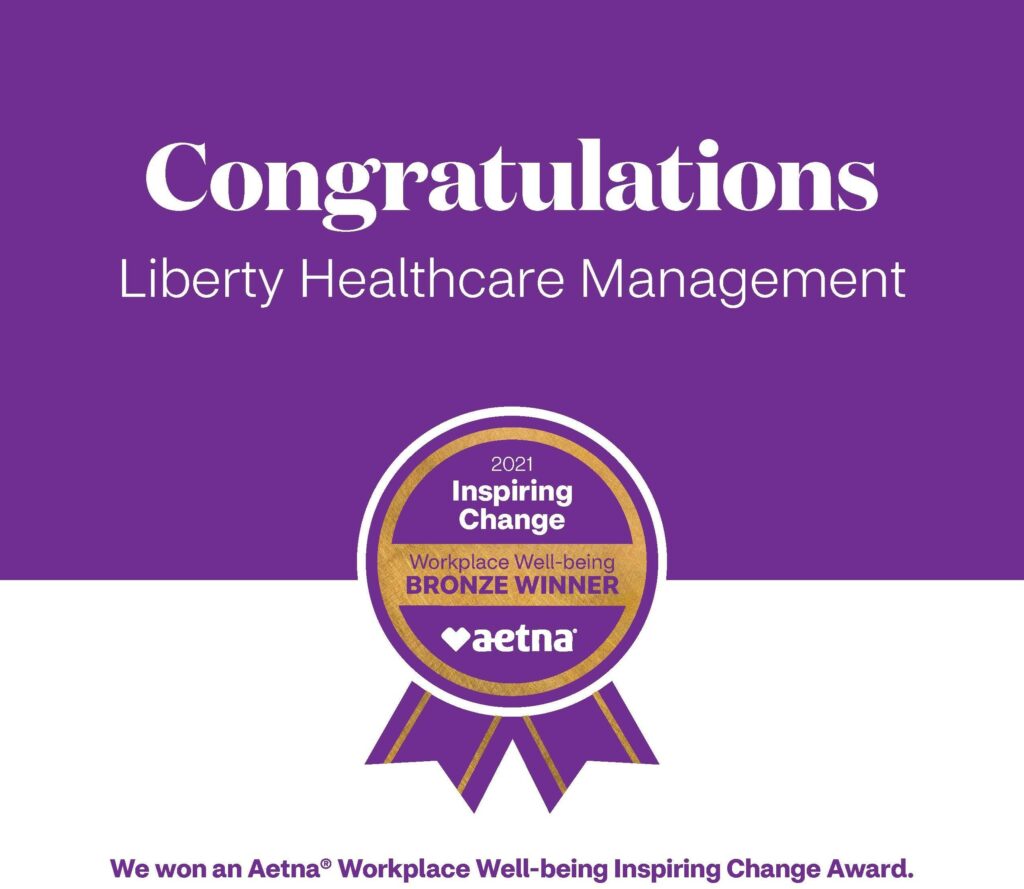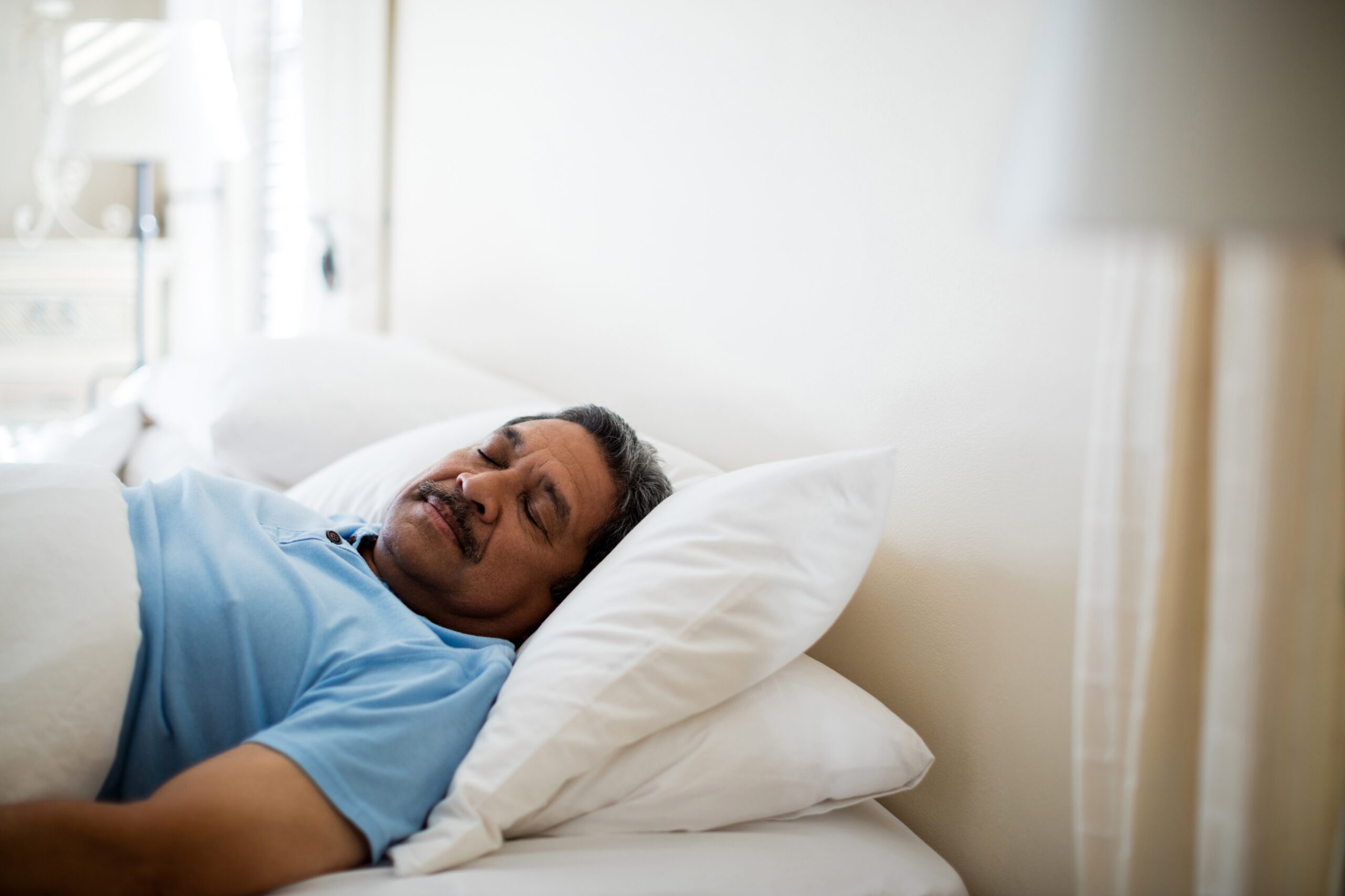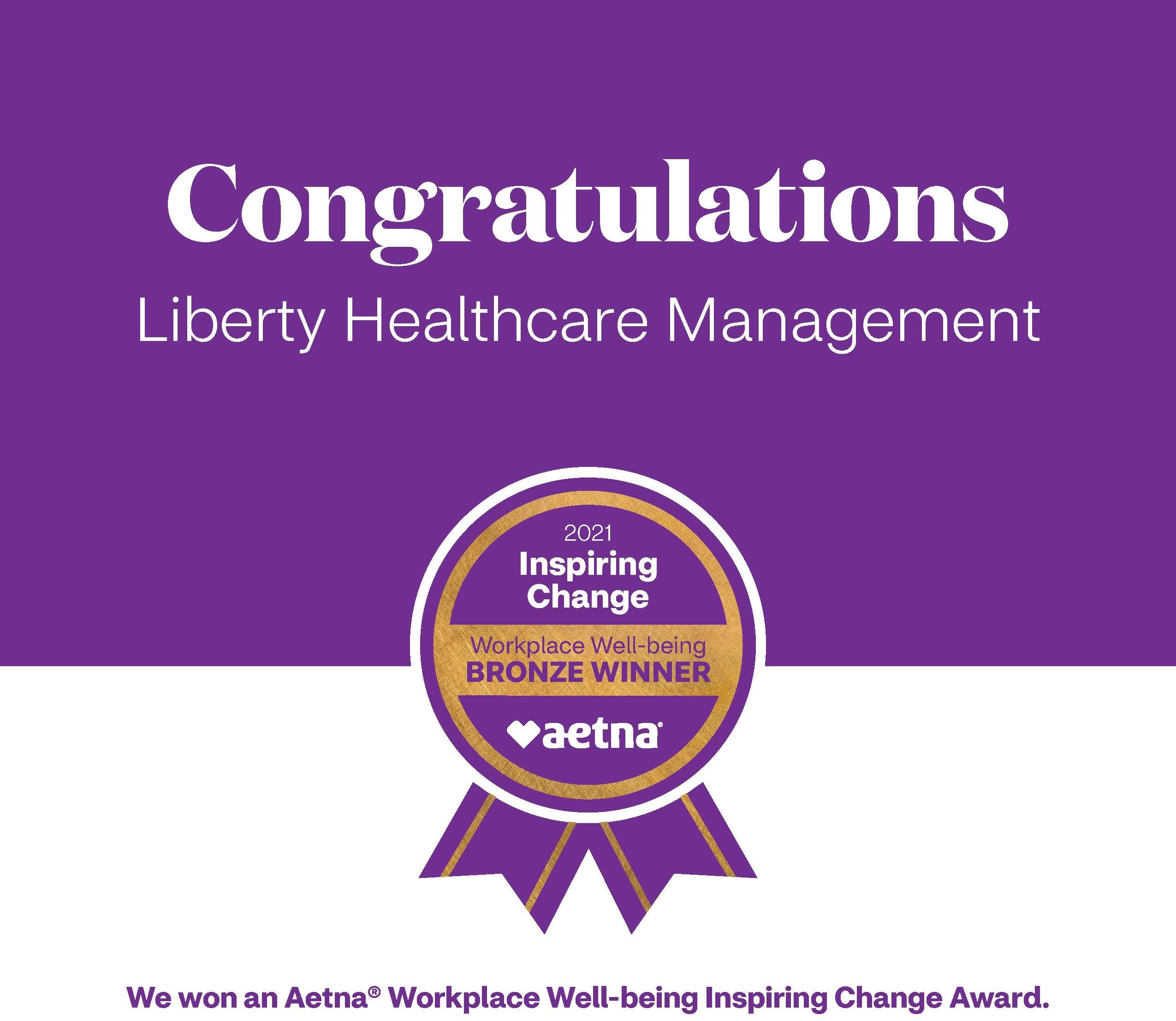Liberty Healthcare’s Commitment To Employee Wellness Earns Award

Liberty Healthcare Management is a proud winner of the Aetna Workplace Well-being Inspiring Change Award.
The Aetna Workplace Well-being Award program aims to create a healthier workplace for employees through innovative programs.
Liberty Healthcare received the award based on an evaluation of our Wellness Discount Program that incentivizes and encourages employees to get an annual physical and other preventative screenings depending on their age.
The requirements for the preventative screenings include:
- Mammogram for women ages 40 to 69 every 12-24 months
- Cervical Cancer Screening for women ages 21 to 64 every 36 months
- Colorectal Cancer Screening for adults ages 50 to 75
o Fecal Occult Blood Test every year
o Cologuard Test every 3 years
o Sigmoidoscopy every 5 years or Colonoscopy every 10 years
By participating in the Wellness Discount Program, an employee can earn $20 extra per pay period or $40 if their spouse participates as well. That adds up to $520 annually for individuals and $1,040 for couples.
Our incredible employees made this esteemed award possible by making their well-being a priority and taking the measures necessary to stay healthy.
Liberty Healthcare’s Well-being Mission:
“Well at work creates and maintains a culture of health by encouraging employees and their families to lead healthier lifestyles, which fosters a more engaged, productive, and committed workforce, and ultimately a more positive work environment.”
The Most Common Health Concerns for Seniors

The CDC indicates that people today are living longer than ever before, specifically another 19.3 years on average. This is a promising sign, especially as our society continues to make advancements in medicine and technology. Of course, as people age, there are new health risks and challenges that they may face. There are several ways to maintain a healthy life, such as regularly exercising, eating healthy, getting enough sleep, going to the doctor for checkups, and managing any chronic or serious health conditions. Let’s take a look at the most common health concerns for seniors and tips for how to better manage these concerns.
1. Arthritis
Arthritis is a leading health condition affecting people aged 65 or older. The CDC reports that 49.7 percent of older adults 65 or older suffer from arthritis. This condition can cause pain and discomfort, which lowers a person’s overall quality of life. It’s recommended for older adults to talk with their primary care doctor about the best treatment options for their unique health needs. This will likely include a personalized plan that includes various exercises, medications, and/or therapy to help patients better manage their health conditions.
2. Alzheimer’s Disease
Did you know one in nine adults 65 or older have Alzheimer’s disease? This equates to about 11.3 percent of the U.S. population. Seniors affected by this chronic health condition may have serious effects on a person’s overall health. This includes their mental health, safety, and ability to live independently.
3. Cancer
To no surprise, cancer is the top second leading cause of death among people over age 65. The CDC reports that about 28 percent of men and 21 percent of women of 65 are currently living with cancer. By receiving important screenings, several types of cancer are treatable. While cancer is not always preventable, there are still ways to improve one’s overall health and well-being. This includes receiving medical treatment and following healthy living practices based on the patient’s specific health condition.
4. Diabetes
Like other health concerns, diabetes is a serious health risk. Around 25 percent of older adults are living with diabetes, while thousands of people die from this condition every year. Luckily, diabetes can be identified and addressed with blood tests that check a person’s blood sugar levels. Once a senior finds out that they have or are at risk for diabetes, they can take the steps to better manage their disease and improve their long-term health.
5. Falls
The risk for falls increases with age. Around 2.5 million seniors are treated in the ER due to serious falls. This can increase a person’s risk for additional falls, as well as the likelihood that they may require care and assistance during their recovery period. For seniors, this is a big fear because it means giving up their independence, even if it’s just temporary. Since falls typically occur in the home, it’s important to follow safety guidelines to prevent seniors from falling.
6. Heart Disease
Heart disease is a serious health concern for people aged 65 and older. The Federal Interagency Forum on Aging-Related Statistics indicates that heart disease is a chronic condition that affects 37 percent of men and 26 percent of women aged 65 and older. There are several factors that can increase a senior’s risk for heart disease, including high blood pressure and high cholesterol. To reduce the risk for this condition, seniors should talk with their primary doctor for suggestions. Their doctor will likely suggest eating healthy, exercising on a regular basis, and getting enough sleep.
7. Obesity
Obesity is another common health concern for older adults. If an older adult is obese, this can increase their risk for cancer, diabetes, and heart disease. For adults between 65 and 74, an estimated 36.2 percent of men and 40.7 percent of women are obese. This can be due to a variety of causes, such as another health condition, lack of mobility, and/or current medications causing weight gain and an increased appetite.
8. Respiratory Diseases
Respiratory diseases are a serious health issue that significantly affects an older adult’s ability to live a healthy life. Common respiratory diseases include asthma, chronic bronchitis, chronic obstructive pulmonary disease (COPD), and emphysema. These diseases also increase a senior’s risk for other health issues, such as respiratory infections and pneumonia. Seniors can better manage their respiratory diseases by visiting their doctor on a regular basis, getting lung function tests, taking their medications correctly, and/or using oxygen as needed. Indeed, this can help patients live a healthier life.
We hope you enjoyed this week’s article discussing several of the most common health concerns for older adults. There are countless more, but these are a few of the most prevalent issues for seniors in the U.S. If you are looking for high-quality care and support for your loved one, look no further than Liberty Healthcare and Rehabilitation Services. We have expert skilled nursing facilities across North Carolina to make it easier to receive the services your loved one needs and deserves.
What You Need to Know About Medicare and Medicaid

When considering affordable health insurance, you have likely heard of Medicare and Medicaid. These government-funded programs are frequently misunderstood. This is not ideal, especially when not knowing what they are or offer can prevent you from getting the care and support you need. Keep reading to learn the differences between Medicare and Medicaid.
What Is Medicare?
Medicare is a program that provides healthcare for Americans age 65 and older and people living with a disability. While Medicare assists with medical costs, it does not fully cover all care, such as long-term care. This program is the main health care insurance company for older Americans. Medicare consists of four parts, including Part A, B, C, and D. These parts cover different health expenses for those that qualify.
Medicare Eligibility Requirements
Check out the Medicare eligibility requirements below.
- Be a U.S. citizen.
- You are 65 or older.
- You are living with a disability.
- You have been diagnosed with end-stage renal disease.
Medicare Enrollment Options
On average, around 10,000 U.S. citizens enroll in Medicare. There are specific enrollment time periods, which are important to be aware of.
- Initial Enrollment Period - People have a seventh month window around their 65th birthday to sign up for Medicare. This enrollment window opens three months before their birthday and then ends three months after their birthday month. It’s recommended to enroll during this early period, so you can avoid any late enrollment penalties.
- General Enrollment Period - The general enrollment period is from January 1st to March 31st every year. If you sign up for Medicare during this period, coverage will start on July 1st of the same year. It’s possible that you may pay a higher Part A or B premium for not enrolling during the initial period.
- Special Enrollment Period - If you are 65 or older and still working, you can enroll at any time you’re still covered in a group health plan or eight months after your coverage ends. This enrollment period is also for seniors that are considering retirement.
Enroll in Medicare
If you do not receive Social Security benefits, but want to enroll in Medicare, visit the Social Security Administration’s Benefits. Or, you can enroll over the phone at 1-800-MEDICARE. After you are enrolled in this program, you will be mailed a red, white, and blue card and welcome packet.
What Does Medicare Cover?
Medicare is broken up into four main sections. The federal government manages Part A and Part B, while private companies contracted through the government manage Part C and Part D. Let’s take a look at what each part covers next.
Medicare Part A
Medicare Part A covers hospital and hospice services. This includes inpatient, hospice, and home health care, as well as short-term care in skilled nursing facilities. Seniors qualify for premium free Part A if they are 65 or older and they worked (or their spouse worked) and paid Medicare taxes for at least a decade.
Typical Hospital Costs Part A Covers:
- Drugs for inpatient treatment
- General nursing care
- Meals
- Other hospital services and supplies as needed for inpatient treatment
- Semi Private rooms
Medicare Part B
Medicare Part B covers preventative and medically necessary care. You will likely pay a premium for this coverage every month. This will be deducted from your check if you receive a Social Security check. For those not receiving Social Security, you will receive a bill in the mail for this care.
Services Covered By Part B
- Ambulance transportation
- Durable Medical Equipment (DME)
- Screenings
- Vaccinations
- Wellness visits every year
Medicare Part C (Advantage Plans)
These plans are offered through private companies that provide coverage to people through Medicare. Several plans provide dental, drug, hearing, and vision services for seniors. The con of this part C is that most plans require you to see doctors that are in network. This limits the number of options you have in your area, unless you can pay high costs for out of network care.
Medicare Part D
Medicare Part D provides coverage for prescription drugs. Enrollment dates are April 1st to June 30th, which would start your coverage on July 1st. When signing up for other types of Medicare, ask about what services are offered. You may discover that some plans cover prescription drugs.
Medigap (Supplement Health Insurance)
Medigap helps cover copays for Medicare Part A and B, as well as any deductibles. While this supplement health insurance doesn’t cover dental, vision, or long-term care, it can help cover healthcare costs when you are out of the country. If you are currently enrolled in a Medicare Advantage plan, you cannot also enroll in Medigap.
What Is Medicaid?
Medicaid is a health care program offering coverage to low-income individuals. While there are federal guidelines to follow, Medicaid services and coverage are operated by individual states. It’s not uncommon for some seniors to qualify for Medicare and Medicaid.
Medicaid Eligibility Requirements
Your eligibility for Medicaid is based on your family’s income, size, and your age. If you have a disability, this also is considered when applying for this program. Since Medicaid requirements change every year, it’s possible that you and your family may qualify after not meeting the requirements during a previous year.
How to Apply for Medicaid
To apply for Medicaid, there are two options. You can contact your state’s Medicaid agency or fill out an application at www.healthcare.gov. It’s recommended to fill out applications online
What Does Medicaid Cover?
While each state operates their own Medicaid program, there are still federal government guidelines that must be met. There may be additional benefits offered, but it depends on the state you live in. It’s recommended to contact your local Medicaid office to determine which benefits are offered in your specific state.
The Federal Government Requires State to Offer These Medicaid Benefits
- Birth center services
- Certified pediatric and family nurse practitioner services
- EPSDT (early and periodic screening, diagnostic, and treatment services)
- Family planning services
- Federally qualified health centers
- Home health services
- Inpatient hospital care
- Laboratory and x-ray services
- Nurse midwife services
- Nursing facility care
- Outpatient hospital care
- Physician care
- Rural health clinic services
- Tobacco cessation counseling for pregnant women
- Transportation services for medical appointments
As you can see, there are major differences in Medicare and Medicaid in terms of who receives benefits, qualifications, and what services are provided. If you are considering affordable health care, we encourage you to research your options to find the best care for your needs. Contact Liberty Healthcare and Rehabilitation Services to learn more about our services, including everything from short-term care to long-term care.
7 Tips for Achieving a Healthy Weight

If you are struggling to maintain or achieve a healthy weight, know that you are not alone. In 2020, an estimated 29 percent of U.S. adults aged 65 or older were obese. To reach your healthy weight goals, it’s important to adopt healthy lifestyle habits. A healthy lifestyle will also help you obtain better health and wellness. Keep reading to discover our top tips for achieving a healthy weight.
Tips to Achieve a Healthy Weight
1. Discuss Your Options with Your Doctor
As you age, there are various factors that affect your weight, such as your age, gender, genetics, lifestyle habits, sleep, and where you live. It’s recommended that you discuss your options with your primary doctor. Your doctor can offer some safe suggestions based on your age, health conditions, and any medications you are currently taking. By getting a recommendation from your doctor, you will be more likely to achieve a healthy weight in a safe manner.
2. Eat Healthy
One of the best tips to help you achieve better health is to eat healthier foods. When you eat the same types and amounts of food, but do not increase your physical activity, this can lead to weight gain. This is due to your metabolism (how your body obtains energy from the food you eat), which slows down as you get older. If you want to lose weight, you need to burn more calories than you consume. For those that need to gain weight, you should burn less calories than you eat or drink.
As for what to eat, it’s a good idea to eat nutritious foods, including fresh fruits and vegetables, whole grains, lean meats, and healthy fats. When possible, limit the amount of food you eat that is high in sodium, sugar, and calories. Like any diet, it’s helpful to have a cheat day to enjoy those special treats that aren’t on the healthy list.
3. Be Mindful of Food Portions
Aside from what you eat, it’s also important to be mindful of how much you eat. If you eat smaller portions throughout the day, this can help you avoid overeating and gaining too much weight. To limit portion sizes, it’s recommended that people 50 or older follow the Healthy U.S. Style Eating Pattern, in which they choose foods from the following list each day:
- Dairy - 3 cups (fat-free or low-fat)
- Fruits - 1 ½ to 2 cups
- Grains - 5 to 8 ounces
- Oils - 5 to 7 teaspoons
- Protein foods - 5 to 6 ½ ounces
- Vegetables - 2 to 3 cups
4. Drink Enough Water
When you drink enough water for your age and size, this helps your body function at optimal levels, reduces cravings in between meals, improves digestion, and helps you maintain a healthy weight. The Obesity Society indicates that drinking enough water every day can also decrease your waistline and help reduce your body fat percentage. Furthermore, drinking more water can prevent you from becoming dehydrated, a health issue that can cause muscle fatigue and pain, as well as heat exhaustion.
5. Keep Track of What You Eat
Like any goal, it’s helpful to keep track of your progress. By keeping track of what you eat and drink, you can see how many calories you are consuming every day. You can use this information to determine any changes you can make to achieve your health goals. For example, if you are trying to shed some pounds, you need to burn more calories than you consume.
6. Exercise Daily
If your doctor has given you the approval for physical activity, this is an excellent way to maintain a healthy weight, achieve long-term health and wellness, stay independent, perform activities of daily living (ADLs), and prevent falls. Try to get 150 minutes of moderate exercise every week, which can be broken up into smaller amounts over the course of the week. Even if you can only do light exercise a couple times a week, it’s still better than no exercise.
As always, it’s best to talk with your doctor about increasing or changing your current exercise routines. Depending on your health conditions and current medications, you may need to avoid certain activities that can cause more harm than good. If you have any of these health concerns, ask your doctor which exercises would be safe for you.
- Blood clots
- Chest pain or pressure
- Dizziness
- Hernia
- Irregular heartbeat
- Joint swelling
- Recent hip or back surgery
- Shortness of breath
Your doctor will also offer some safety tips or specific exercise suggestions that would help you achieve your goals. Remember that you don’t need an expensive gym membership or at-home equipment to get active. There are plenty of options to try, so it’s most important that you find something you enjoy and is safe for you.
Exercise Ideas:
- Bicycling
- Cleaning your house
- Dancing
- Gardening
- Running
- Swimming
- Walking
7. Get Enough Sleep
The Sleep Foundation indicates that between 40 to 70 percent of older adults may have chronic sleep issues, which can affect your ability to perform daily activities and live the highest quality of life. Since getting enough sleep is crucial for achieving better health, recharging your body, and reducing the risk of overeating, it’s important to get 7 to 8 hours of sleep a night. For those that struggle to fall or stay asleep, consider adopting a bedtime routine to help you sleep. This can involve activities that you find relaxing, such as meditating, praying, stretching, or yoga.
As you can see, there are numerous ways to achieve a healthier weight. These tips also have additional benefits for your health, such as more energy, better overall health, improved strength and balance, all of which can help you maintain your independence. At Liberty Healthcare and Rehabilitation Services, we offer a wide range of expert services designed to help you achieve your unique health goals. Our compassionate staff and therapists are equipped to help you regain your function and independence, improve your health, and better manage your health conditions.
Assisted Living for People with Disabilities

Did you know that 2 out of 4 American adults age 65 or older live with at least one disability? Despite their challenges, most disabled seniors strive to live as independently as possible. There are a variety of disabilities, which can affect people in different ways. A disability can have a direct impact on a person’s ability to safely live on their own. A disabled person is defined as someone who has challenges with performing activities of daily living (ADLs). While most people think of a person in a wheelchair, the reality is that most disabilities are “invisible” to others. Let’s take a look at assisted living options for older adults with disabilities.
What Are the Assisted Living Options for Disabled Seniors?
Under Title II of the American Disabilities Act (ADA), people with disabilities must have equal house opportunities. This law has helped improve the quality and quantity of housing options for disabled people. There are a wide variety of disabilities, which affect people in unique ways. The four main disability categories include the following:
- Intellectual disabilities: this affects a person’s ability to communicate, learn, and remember information.
- Mental disabilities: this affects a person’s behavior, emotions, and thoughts.
- Physical disabilities: this impacts a person’s physical health, such as their mobility
- Sensory disabilities: this impacts a person’s senses, such as blindness or hearing loss.
In general, physical and sensory disabilities are the most common types that impact a person’s housing needs. Positive changes have been made today to ensure that disabled seniors can safely live at home, such as including ramps and handrails both inside and outside of their homes.
- Assisted Living Facility - these facilities provide expert care to older adults who are no longer able to safely live independently. These seniors may require assistance with ADLs. In general, assisted living offers either private or semi-private apartment-style rooms with a living area and kitchenette.
- Nursing Homes - these facilities offer a supportive environment and skilled nursing care. It’s common for nursing homes to offer private and semi-private dormitories or apartment-style rooms for residents.
- Skilled Nursing Facility - these facilities provide 24/7 medical care to patients in need of specific medical needs from a professional licensed staff. Like other facilities, skilled nursing offers both private and semi-private rooms in a comfortable home-like atmosphere.
- Continuing Care Retirement Communities (CCRs) - these facilities offer a complete continuum of senior care, such as independent living, skilled nursing, and more. In general, residents must be able to live independently when they arrive. However, some communities provide specific care for additional fees. You can expect to find apartments, cottages, condos, duplexes, and townhomes.
How to Find an Assisted Living Facility for Disabled Seniors?
If your loved one is looking for an assisted living facility near them, there are several options to find the best one for your loved one’s health needs.
- Check out a national assisted living directory.
- Search on Google for assisted living facilities near you.
- Contact us for assistance with finding out how Liberty can best help your loved one.
- Explore our services page to discover how our assisted living can meet your loved one’s needs.
- Visit Liberty’s website to find a skilled nursing facility near you.
Common Assistive Devices to Promote Independence
Assistive devices are specific tools designed to help improve a person’s independence. Common assistive devices include canes or walkers used to help a person stay mobile and to support them while standing and walking. These devices help older adults achieve a higher quality of life and boost their independence. This allows older adults to live safely on their own, even if that means it’s no longer in their home.
Examples of Assistive Devices
- Adaptive clothing to help older adults easily get dressed.
- Applications designed to make phones and tablets touch-free.
- Computers that offer assistance like medication reminders and answering questions (i.e. date, time, weather, etc.).
- Door knock notifications for those that are deaf or have hearing loss.
- Large print keyboards and large display clocks for those with visual impairment.
- Modified keywords, such as LUCY.
- Robot vacuums and mops that self-clean the senior’s home on a regular basis.
- Voice recognition products.
As the need for assistive technology increases, it’s important to do your research for the best products for your loved one. For any devices that are connected to a computer, it’s important to ensure that the device is compatible with your computer’s operating system (OS). After all, you want to ensure that your loved one can easily use the devices designed to help them.
We hope this article helped provide an overview of your loved one’s assisted living options. Since many seniors are living with disabilities, it’s important to know what their options are regarding where to live and how specific facilities can help them achieve a high quality life and more independence. At Liberty Healthcare and Rehabilitation Services, we provide expert services at all of our assisted living facilities in NC. Contact us today to learn how we can help your loved one receive the care and support they deserve!
How Sleep Impacts Your Health

The CDC reports that around 70 million Americans have chronic sleep issues. These sleep issues can lead to numerous health risks, including chronic illnesses, diabetes, injuries, mental illnesses, obesity, poor health, reduced work productivity, and more health care costs. It’s no surprise that not getting enough sleep can have a negative impact on your health, especially as you get older. Let’s take a look at how sleep impacts your loved one’s health and tips to get better sleep today.
How Does Sleep Affect Older Adults’ Health?
When you don’t get enough sleep, this can prevent you from living the highest quality of life. A lack of proper sleep can make it challenging to perform daily activities. Not being able to perform ADLs (activities of daily living) can prevent an older adult from living independently in their home.
Additionally, studies have shown that poor sleep can lead to obesity. This is because sleep regulates the hormones that are responsible for telling your body when you are hungry and full. Thus, not getting enough sleep can lead to an older adult eating more unhealthy foods.
Did you know sleep affects your mental health, immune system, and ability to control emotions. If your loved one is regularly sleepy during the day, this can increase their risk for falls and injuries. In the case of an emergency, those with sleep problems may be slower to respond to emergencies, such as a house fire.
How Much Sleep Do Older Adults Need?
This may be surprising, but older adults still need about 7 to 9 hours of sleep each night. The National Sleep Foundation conducted a survey of older adults and found that 30 to 39 percent of these adults reported having issues with sleeping. As people age, it’s common for it to take longer to fall asleep and stay asleep. This can be a result of medications, bathroom breaks, or medical conditions that interfere with an older adult’s sleep. Of course, the most important part is that a person is able to fall back to sleep and get enough sleep.
What Factors Cause Poor Sleep?
There are numerous factors that can lead to poor quality sleep. Due to COVID-19, many older adults have been affected by this pandemic. For example, older adults may have experienced more stress, sickness, social isolation, and loneliness, as well as less sleep, physical activity, and joy. In turn, this can make it difficult to fall asleep. If an older adult is taking certain medications, these can keep them from falling asleep easily.
If an older adult is feeling very tired during the day, this may be an indicator of a serious sleep issue like obstructive sleep apnea (OSA), cognitive impairment, or cardiovascular issues. For those with OSA, this is when weight placed on the upper chest and neck leads to air flow being blocked. Common symptoms include drowsiness and snoring, as well as gasping, dry mouth, and headaches. As people age, the risk for OSA increases and can contribute to poor health and increased risks of accidents, injuries, and obesity.
When it comes to food, overeating and eating too much unhealthy food can contribute to poor sleep. Specifically, food with low fiber and high amounts of added sugars and saturated fats can negatively affect an older adult’s ability to sleep. This includes butter, cheese, and red meat.
As always, it’s recommended to discuss with your doctor if you're concerned about sleep issues due to sleep apnea, an illness, or current medications.
Tips for Better Sleep
If you are having trouble sleeping, there are tips you can follow to improve your quality of sleep. Sleep experts recommend adopting a healthy lifestyle, which can positively affect your overall long-term health, well-being, and ability to sleep. Consider the following tips below to achieve better sleep.
1. Use Your Bedroom for Sleeping
If possible, it’s best to use the bedroom for sleeping. This will help your body and mind associate this room for one primary use, to relax and go to sleep. It’s best to not eat or work in this room. Keep your room at a comfortable temperature. While it may be difficult, try to keep computers, phones, tablets, and TVs out of your bedroom, which will reduce the temptation to be on device late at night.
2. Don’t Stress About Waking Up at Night
As adults age, waking up at night may become quite familiar. It’s important to remember that this is very common. As long as you are able to fall back to sleep, it’s not a big concern to wake up to use the bathroom or get a glass of water. For those that are having trouble going back to sleep, try to get up, read a book for a few minutes, or listen to relaxing, quiet music. Once you become sleepy again, it should be easier to go back to sleep.
3. Follow a Bedtime Routine
Choose a bedtime routine that helps you relax and prepare for sleep. It’s a good idea to limit your screen use, especially when social media, news, and YouTube videos can overstimulate the brain to stay awake longer. A few helpful alternatives to relax include listening to soft music, reading a book, or writing in a journal. This will have a calming effect that prepares your mind for lights out.
4. Avoid Specific Foods and Drinks Before You Go to Bed
Alcohol and sleep aids can make it more difficult to get restful sleep. To help you get quality sleep, it’s wise to avoid eating large meals or snacks before bed. Also, caffeine can keep you awake at night as it can stay in your bloodstream for up to 12 hours after drinking your favorite cup of joe. If you’re having trouble sleeping, it’s a good idea to limit your caffeine intake in the evenings.
5. Do Things That Bring You Joy
As much as possible, do at least one thing a day that brings you joy. This will be different for everyone. However, some suggestions include visiting family, video chatting with a friend, writing letters to others, gardening, or making a new dish. When you do something that you love, this can help lower your stress levels and feel more content with life. In turn, it will be easier to fall asleep when you have done something that was fulfilling.
6. Exercise On a Regular Basis
Getting regular exercise and fresh air is an effective way to improve your mood and outlook on life. While you’re outside, the sunlight will tell your brain that it’s daytime. In turn, being outside will help you adopt a normal sleep and wake routine.
As you can see, there are several factors that can impact your ability to fall and stay asleep. We hope these tips will help you achieve better sleep. With better sleep, you will naturally feel more energized, healthier, and happier. Contact Liberty Healthcare and Rehabilitation Services today to learn about how we are redefining healthcare to meet your needs. We provide everything from short-term rehabilitation and long-term care to therapy services and skilled nursing.
Easy Ways to Prevent Falls

The CDC reports that one in four older Americans fall every year. Falls are the leading cause of injury and death for people aged 65 and older. Common fall injuries include broken bones, head injuries, and hip fractures. When an older adult falls, this can also lead to emotional stress. Indeed, this can interfere with an older adult’s ability to stay healthy and independent, as well as safely live on their own. If you have an aging loved one, neighbor, or friend, keep reading to discover some easy tips to help them prevent falls.
How to Prevent Falls
There are several easy ways to make your loved one’s home safer. A safer living space can help prevent falls at home. This will allow your loved one to continue living independently and safely in the place they love most - their home.
1. Remove the Clutter
This is one of the easiest tips to prevent falls in the home. By keeping the home free of clutter, your loved one will find it easier to get around without accidentally tripping or losing their balance. Clutter can include stacks of paper and magazines, shoes, and toys on the floors, hallways, and stairs. Indeed, this tip is especially useful for aging adults that have vision impairments and may not see something on the floor or stairs.
2. Fix or Remove Tripping Hazards
To help prevent falls, it’s a good idea to regularly check for tripping hazards in the home. You can help check your loved one’s home by looking through every room, hallway, and closet for any potential hazards. This can include loose carpet, slippery rugs, or wooden floorboards that are not secured in place. By fixing or removing these hazards, you can help prevent your loved one from falling and injuring themselves. Depending on the injury, this could be serious enough to require an ER or hospital visit and months of recovery in long-term care.
3. Install Handrails or Grab Bars in the Home
Did you know handrails and grab bars are an effective safety aid for older adults? This can make your loved one’s home safer, which will give you peace of mind. Key areas of the home to install handrails or grab bars include the staircase and bathroom (next to the toilet and in the bathtub). If you are unable to set this up, you can hire an expert handyman to set these safety aides up for your loved one.
4. Wear Proper Fitting Clothing
It’s a good idea for your loved one to wear proper fitting clothes at home. It may be tempting to wear loose fitting clothes, but this can increase their risk for falls. Clothes that are too big or drag on the floor can get caught under their feet or furniture, thus causing a potential fall.
5. Use Proper Lighting Inside the Home
It’s important that your aging loved one’s home has proper lighting that makes it easy to see in every room and hallway. If your loved one has trouble seeing due to poor lighting, this could lead to a serious fall. If your loved one needs to get up in the night, using nightlights in the bedroom and bathrooms makes it easier to see in the dark.
6. Wear Shoes or Non-Slip Socks
While socks are comfortable, they pose a risk for slipping on hard floors, such as in the kitchen and bathrooms. By wearing shoes or non-slip socks, older adults will be able to grip the floor more easily. This is important for maintaining their balance and thus, reducing their risk of falls.
7. Use Non-Slip Mats
It’s no surprise that floors become dangerous when they are wet from a spill or cleaning. For hard floors, consider using non-slip mats to prevent falls on these potentially slick surfaces. This includes bathrooms (i.e. showers or bathtubs), kitchens, and porches.
8. Live On One Level
When possible, it’s recommended for seniors to live on one level. Even with stair railings, there is a serious fall risk with climbing up and down stairs. If your loved one is not able to live in a single level home, encourage them to limit the trips they take up and down the stairs. It helps to have friends and family that can come over, who could help clean the upstairs of their home.
9. Get Up Slowly
When your loved one gets up from laying down or sitting, encourage them to do this slowly. This will help them gain their balance before they start walking. By doing this simple step, they can significantly reduce their risk for falls. This same advice goes for going up or down the stairs. Just take a breath and pause for a moment before moving.
10. Discuss Their Health Conditions
Encourage your loved one to talk with their doctor about their current health conditions. It’s important that they are honest about any issues they are having with their health, taking medications, or staying mobile. Their doctor will be able to evaluate their health conditions and offer recommendations for how to help reduce their risk for falls. By reducing their risk for falls, they will be able to maintain their independence at home.
As you can see, there are several easy tips to prevent falls. You and your loved one can discuss these tips, which is a great starting point to improve their home’s safety. After all, it’s important that your loved one can maintain their health and independence in a safe home environment for as long as possible. If your loved one is recovering from an injury, illness, or surgery, contact Liberty Healthcare and Rehabilitation Services today. We would love to help your loved one regain their independence and achieve their health goals through our short term rehabilitation, assisted living, skilled nursing, or outpatient therapy.
What You Need to Know About Senior Living Assessments

When it comes to your loved one, their health and well-being is a top priority. You want them to be as safe and independent as possible. As your loved one ages, they may experience certain challenges that require expert care and support from a senior living facility. It’s important to research your loved one’s options and find the best choice for their unique health needs. To provide the best care and support possible, senior living facilities will perform senior living assessments. This is a necessary step to determine your loved one’s physical and mental health, so the facility can provide the appropriate care that will help your loved one achieve their health goals and regain their independence. Keep reading to find out what you need to know about these assessments for your loved one.
What Is a Senior Living Assessment?
A senior living assessment is used to determine your loved one’s unique care needs. A nurse or admissions staff member typically performs this assessment, which is done at the facility. The assessment will help the facility determine what type of care your loved one will benefit from the most, such as assisted living, short-term rehabilitation, or long-term care. Additionally, this assessment will help the facility create a personalized care plan for your loved one.
What Does a Senior Living Assessment Evaluate?
Typically, an assessment will evaluate and rank your loved one’s behaviors, illnesses, food requirements, need for assistive technologies, and ability to communicate, perform ADLs, and manage medicine. Family members and caregivers are encouraged to come to assist with answering specific questions about their loved one’s level of functioning. While it may be challenging to complete this assessment, this information will help facilities gain a better understanding of what your loved one needs regarding their care and support.
- Activities of Daily Living (ADLs): Can your loved one perform ADLs, such as bathing, dressing, and feeding themselves or taking their medication and cleaning?
- Dietary Needs: What type of dietary needs and restrictions do they have? For example, do they need to follow a low-sodium or low fat diet? Do they have any food allergies?
- Fall History and Risk: Has your loved one fallen in the past or recently?
- Health Issues and Conditions: Does your loved one have any serious or chronic health conditions? Do they have any of the following: arthritis, cancer, dementia, diabetes, digestive issues, hearing impairment, heart issues, high blood pressure, stroke, or visual impairment? If yes, how do these conditions affect their ability to function and live independently?
- Housekeeping: Is your loved one able to clean their house on their own? This includes basic chores like washing dishes, cleaning up their main living spaces, and doing laundry.
- Mental Condition: Does your loved one have any mental conditions? Are they able to remember people, places, and what time it is? Do they suffer from regular or frequent confusion, such as forgetting where they live or who their family is?
- Mobility: Is your loved one able to move around their house on their own or do they require assistance? If they require help getting in and out of bed and chairs, do they use a wheelchair or other assistive device?
- Special Medical Services: Does your loved one need special medical services, such as an oxygen tank?
- Toileting Assistance: Does your loved one need help using the bathroom? Do they suffer from incontinence? If yes, can they go to the bathroom on their own with the help of assistive devices? Does your loved one need to be reminded to go to the bathroom?
- Transportation: Can your loved one drive themselves to the grocery store and doctor’s office? If not, can they use public transportation on their own?
The Best Option for Your Loved One
As you can see, there are numerous factors that are considered when conducting senior living assessments. After reading this article, we hope you are now ready to start exploring senior living facilities in your local area. It’s best to not wait until the last minute when your loved one is no longer able to live on their own safely. If you are looking for a family-owned, local business with several senior living options, contact Liberty Healthcare and Rehabilitation Services today. We offer everything from short term rehabilitation to assisted living and long-term care to skilled nursing facilities.
What Are the Benefits of Working In a Long-Term Care Facility?

Do you enjoy helping others, making a difference in your community, and forming bonds? If you said yes, you may want to consider a nursing assistant career in a long-term care facility. For nursing assistants, you will enjoy several benefits from working in a long-term care facility. Let’s take a look at those benefits now.
Get to Know Patients
Patients that receive long-term care will generally live at the skilled nursing facility for a long time, such as for weeks, months, and even years. This is far different from hospital settings where patients are only there for a few days. By working at a long-term facility, this gives you an opportunity to get to know patients and their families on a personal level. These bonds with your patients help create a rewarding, meaningful career.
Learn from Patients
As you get to know your patients, you will discover that each person has a unique story to tell, wisdom to share, and joke to make your day. For senior patients, they have lived a long, full life and will most likely be willing to share some life lessons with you. By listening to their stories and showing interest, you can learn a great deal from the elderly.
Your Services Will Be Appreciated
No matter what role you play at work, you will likely be providing basic care for your patients. This care may include changing bedding, helping patients with personal hygiene, or even going on a walk. Since patients in long-term care facilities can no longer live independently, most will be grateful for your daily care and support. Additionally, your patients’ family and friends will appreciate the compassionate services you provide to their loved ones. Indeed, this gives them peace of mind that their loved ones are in good, caring hands.
Continue Learning About Aging
Aging is a natural process that everyone experiences. By working with patients in long-term care, you will learn more about the aging process beyond what was taught in school. Aside from the educational aspect, this career will also help you develop more compassion for those easing through a natural stage of life. When you need to take care of an aging loved one in your family, this experience will help prepare you for those challenging days ahead.
Work in a Supportive Environment
When you work in a caring and supportive environment, this leads to a highly rewarding job that you look forward to going to each day. Like you, other health professionals choose to work in long-term care facilities to have a positive daily impact on their patients’ lives. You will find that your co-workers are kind, compassionate, and empathetic individuals that care about the health and well-being of each patient.
As you can see, there are several benefits to working at a long-term care facility. If you are interested in starting a rewarding career in long-term care, contact Liberty Healthcare and Rehabilitation Services today. We offer competitive compensation and benefits packages, flexible scheduling, a 401 (k) retirement plan, referral bonuses, and more.
Short-Term vs. Long-Term Rehab vs. Outpatient Therapy for Patients

Whether you or your loved one is recovering from an injury or surgery or living with a serious illness or disability, there are several options to help improve your quality of life and regain your independence. In case you didn’t know, Liberty Healthcare and Rehabilitation offers short-term and long-term rehabilitation, as well as outpatient therapy for patients. The best type of care will depend on your unique health needs. Let’s take a look at the differences regarding short-term and long-term rehab, along with outpatient therapy, which will help you determine the best choice for you or your loved one.
Short-Term Rehabilitation
Short-term rehab provides services designed to help patients’ recover from any injury or surgery, to regain strength and mobility, and to achieve the highest quality of life possible. If you or your loved one has had a chronic condition or slow recovery from surgery, this short-term care helps rebuild your abilities and improve your strength, overall health, and confidence. The main focus is to help you return to your prior living setting as quickly and safely as possible. Since this is a temporary solution, patients can focus on reaching their goals while a care team assists with activities of daily living (ADLs).
In general, short-term rehab is covered by Medicare and other major insurances. Patients that receive short-term care have access to a professional care team, including nurses, doctors, and therapists. Once the patient’s doctor has determined that the patient is fully recovered, the next step is for the patient to return to their prior living setting, usually at home.
Long-Term Rehabilitation
With certain health conditions, injuries, or disabilities, you or your loved one may still require additional rehabilitation. Long-term rehabilitation is an excellent option that provides a homelike atmosphere and constant nursing care. If patients do not need short-term rehab, they can still benefit from long-term rehab if they are living with degenerative diseases, such as Alzheimer’s or Parkinson’s disease. The main goal with this care is to provide a safe, supportive, and stable environment where patients can live the highest quality of life possible and engage with others while receiving assistance as needed. Long-term rehab facilities are usually offered through senior living communities or skilled nursing communities.
Outpatient Therapy
Outpatient therapy is for patients that need an individual treatment plan that may include physical therapy, occupational therapy, and speech therapy. Each patient’s treatment plan is designed to help patients maximize their outcomes and quality of life. This plan will focus on helping patients overcome functional, physical, and/or communicative challenges. With this therapy, patients will return home in between their therapy sessions. Patients will continue their exercise at home according to their doctor’s instructions. Indeed, outpatient care is a great way to help patients transition from inpatient care to a patient’s prior living setting.
Caring with Excellence
At Liberty Healthcare and Rehabilitation Services, our short-term and long-term rehab is available for our residents that qualify for this care. Our rehabilitation provides physical, occupational, and outpatient therapy services to those that need it. Liberty’s expert team provides compassionate care and support to help our residents achieve their health goals. By putting our residents in control, this allows them to determine how they spend their day, such as when they wake up, eat, and what activities they participate in. This helps us provide caring with excellence in a way that helps residents live a healthy, happy, and meaningful life. When residents are feeling good, this will help motivate them to achieve their goals and regain their independence. If you or your loved one is interested in short-term rehabilitation or long-term rehabilitation services, contact Liberty Healthcare and Rehabilitation Services in Wilmington, NC today.


